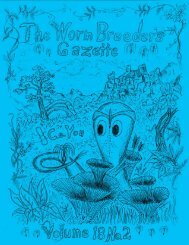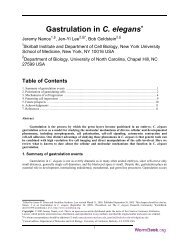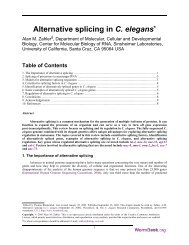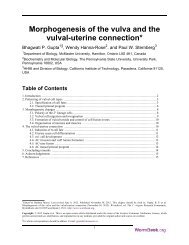Worm Breeder's Gazette 17†4‡ - WormBook
Worm Breeder's Gazette 17†4‡ - WormBook
Worm Breeder's Gazette 17†4‡ - WormBook
You also want an ePaper? Increase the reach of your titles
YUMPU automatically turns print PDFs into web optimized ePapers that Google loves.
Baseline data for worms grown in C. elegans Maintenance Medium<br />
Nate Szewczyk 1,2 , June Sunga 1 , Cassie Conley 1<br />
1NASA Ames Research Center, M/S 239-11, Moffett Field CA 94035-1000<br />
2nate@alumni.cmu.edu<br />
Growth of C. elegans in axenic medium was proposed prior to development of the worm as a<br />
genetic system. Dougherty saw the utility of C. elegans as a genetic system and was<br />
interested in axenic cultivation in order to apply genetics to the study of worm metabolism.<br />
Development of a chemically defined axenic medium for C. elegans cultivation ultimately<br />
proved a long road and in the interim the worm has become a genetic model system. Most of<br />
our community grows animals on NGM and because of the large base of knowledge of animals<br />
on NGM there is good cause to continue to use NGM.<br />
However, there are a number of reasons to consider use of an alternative medium for worm<br />
growth and as a result a number exist. Unlike some media the chemically defined, axenic C.<br />
elegans Maintenance Medium 1 (CeMM) can be used either in a liquid or solid state in petris or<br />
any of a number of standard cell culture containers. Solid state use provides the same general<br />
benefits as NGM although it is harder to get animals to mate and animals tend to burrow.<br />
Liquid phase use provides the ability to cultivate large numbers of animals and to automate<br />
culturing and experimentation. Because CeMM is chemically defined one has the advantage of<br />
altering the chemical composition if desired and its use removes the caveats associated use of<br />
undefined medium or E. coli.<br />
To assist in wide spread use of CeMM we have collected data on the life-cycle of C. elegans in<br />
CeMM, just as baseline data was collected for grown on NGM early in the development of C.<br />
elegans research. Animals grown in or on CeMM grow and reproduce for at least 8 weeks<br />
regardless of temperature (15°->25°C) and without medium exchange. Similar to NGM grown<br />
animals, animals grown in CeMM undergo four moults and display temperature sensitivity of<br />
growth rate, brood size, and life-span. At 15°C animals reach a length of 1 mm in about 9.5<br />
days, begin laying eggs on day 9, lay a total of 107 ± 58 eggs and cease laying eggs on day<br />
19. At 15°C animals have mean and maximum life spans of 41 and 112 days. At 20°C<br />
animals reach a length of 1 mm in about 7 days, begin laying eggs on day 7, lay a total of 81 ±<br />
31 eggs and cease laying eggs on day 14. At 20°C animals have mean and maximum life<br />
spans of 30 and 93 days. At 25°C animals reach a length of 1 mm in about 5 days, begin<br />
laying eggs on day 5, lay a total of 42 ± 18 eggs and cease laying eggs on day 9. At 25°C<br />
animals have mean and maximum life spans of 17 and 37 days. These data combined with the<br />
results of analyses of lipid and protein stores and microarray analysis of CeMM grown versus<br />
NGM grown animals suggest that animals have different metabolisms depending upon the<br />
media type. Thus, those wishing to use CeMM should be aware that, as with all media, there<br />
are caveats associated with use of CeMM and potential pitfalls of applying what is known of<br />
the animals on NGM to animals in CeMM. Pre-made 2x CeMM can be obtained from Fisher,<br />
please contact the Conley Lab for further details.<br />
This research was funded by NASA Fundamental Biology and the NASA Astrobiology Institute.<br />
1 Lu, NC; Goetsch, KM. Carbohydrate requirement of Caenorhabditis elegans and the final<br />
development of a chemically defined medium. Nematologica 39(3): 303-311, 1993










